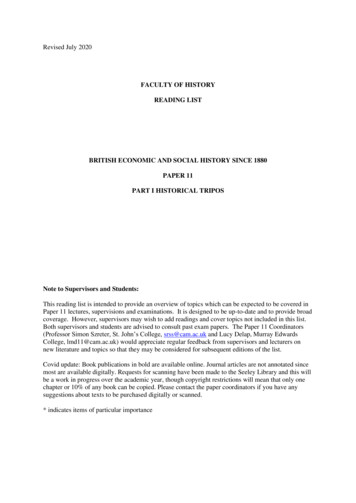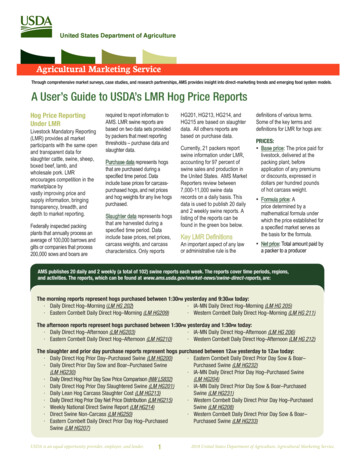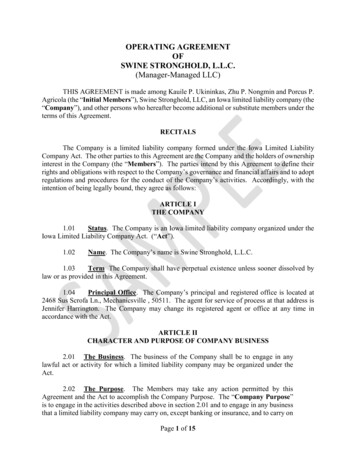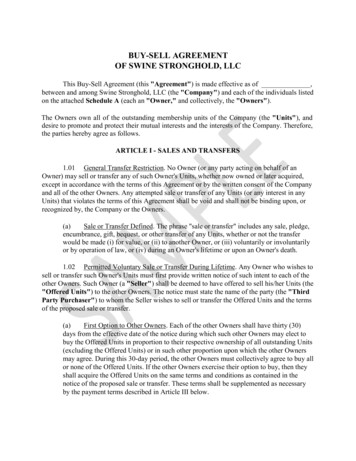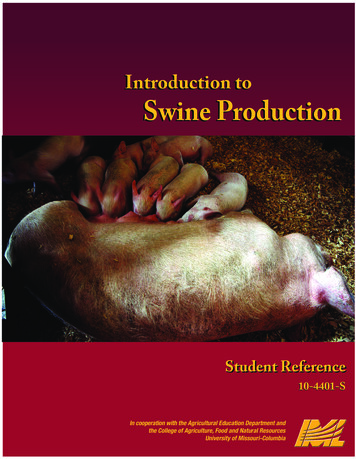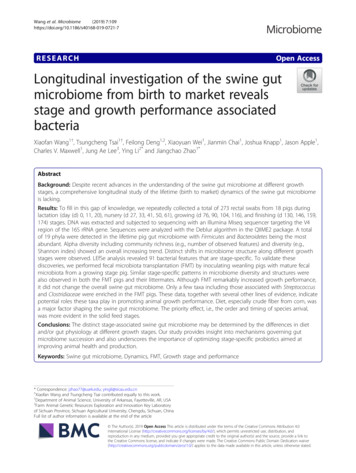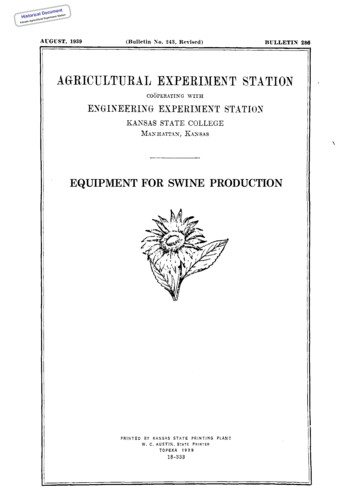
Transcription
tcumen oncal DoHistori ural Experiment StatiKansasAgricultEQUIPMENT FOR SWINE PRODUCTION
tcumen oncal DoHistori ural Experiment StatiKansasAgricult
tcumen oncal DoHistori ural Experiment StatiKansasAgricult
tcumen oncal DoHistori ural Experiment StatiKansasAgricultEQUIPMENT FOR SWINE PRODUCTION1B. M. ANDERSON² and V. R. HILLMAN³INTRODUCTIONIt is the purpose of this bulletin to enumerate a number of theessential and desirable features of swine-production equipment andto describe and illustrate a variety of buildings and equipment t h a thave proved practical on Kansas farms and elsewhere. It is notexpected that all the suggestions are equally applicable to everyindividual farmer, but that each may find some hints whereby hemay be able to increase the efficiency of his pork-production plant.IMPORTANT FEATURES OF HOG-HOUSE LOCATIONThe following fundamental requirements affecting the location ofhog houses have general application.1. Sufficient Drainage.-Rolling ground is unquestionably bestfor drainage, since low, level land is more likely t o be damp and unsuited for swine. Sandy soils furnish a desirable base because waterdrains through them readily. Heavy clay gumbo or other waterholding soils are to be avoided. Drain tile may often be used to advantage in soils not having good natural drainage.2. Sunny Exposure.- An open, well-sunned space, where directsunlight will strike the house throughout the day, should be selected.It is best t o avoid the heavy shade of trees and other buildings.3. Southern Slope.-A southern slope is preferable because ofits sunny exposure, which means much to the successful raising ofsuckling pigs. Warmth, dryness, and natural air drainage, all conducive to the best results with pigs, are promoted by the southernslope.4. Protective Windbreaks.-The extremely cold winds in Kansas come from the northwest. The most efficient site, therefore, issoutheast of a good, substantial windbreak of hills, trees, buildings,fences, or their combination.5. Nearness to Pasture and Summer Shade.-Convenientpasture and summer shade are both indispensable for economicalpork production.(5)
tcumen oncal DoHistori ural Experiment StatiKansasAgricult
tcumen oncal DoHistori ural Experiment StatiKansasAgricult
tcumen oncal DoHistori ural Experiment StatiKansasAgricult8KANSAS B ULLETI N 2866. Suitable Elevation.-The high situation is likely to be bleak,cold, and inconvenient; the low, damp and unhealthy. A mediumelevation, neither too high nor too low, is desirable.7. Prevention of Odors Reaching Dwelling.-Inasmuch assomewhat unpleasant odors may emanate from swine shelters, thepiggery should be a reasonable distance from the farmhouse, andpreferably not in the direction whence the prevailing winds come.8. Least Possible Risk from Disease Infection.-Locationsclose to public highways, railroads, and open waterways, unless freefrom possible infection, are to be avoided. The neighbor's herd maycarry infection and this source of danger should be considered.Reasonable isolation of the swine herd is advantageous.9. Economy of Labor and Time in Management.-To savetime and energy, feed, water, and bedding should be near at hand.The location of the hog house should fit in with the general schemefor doing farm chores efficiently.IMPORTANT FEATURES OF HOG-HOUSE CONSTRUCTIONHog houses, although built in many types, should have in commonthe characteristics discussed below. (Figs. 1 to 10.)1. Warmth.-The hog house should be sufficiently warm thatthe pigs never will have to pile up to keep warm. Hogs lack thenatural coat of other farm animals and huddle up when cold. Thisoften results in pneumonia or suffocation.2. Ventilation.-Fresh air is equal in importance to feed anddrink. Ventilating and keeping the house warm at the same timecalls for correct construction and accurate knowledge as t o requirements. Ventilation in the hog house is as fundamentallynecessary as warmth.3. Sunlight.- Direct sunlight promotes the health and vigor offarm animals. During the late winter and early spring months inthe North Central states the sun shines only about one-half thetime, and the animals seek the sunny spots in winter, even climbing up on manure piles, or other elevations, to catch the first raysof the sun. Direct sunshine at some time during the day shouldstrike every part of the interior of the well-designed hog house,especially the floors of the pens during the farrowing months ofFebruary, M a r c h and April.4. Dryness.- The difficulty in keeping makeshift quarters dryhas been the cause of many runts and dead pigs. A dry, well-
tcumen oncal DoHistori ural Experiment StatiKansasAgricultEQUIPMENTFORSWINE PRODUCTION9drained floor and weatherproof and waterproof roof and walls arevery necessary.5. Sanitation.- The hog is one of the cleanest of our domesticanimals-when given the opportunity. H e will keep his bed scrupulously clean if given half a chance. The hog always breathes, eats,and drinks close to the ground. The well-planned hog house, therefore, must provide for quick, easy, and frequent cleaning. Smoothwalls and floors without crevices are necessary, and these makepossible more thorough disinfection.6. Safety and Comfort.-Comfortable hogs housed in safequarters are the biggest money makers. Unless careful attentionis given to every detail there will be many unsuspected leaks in theprofits. High doorsills frequently cause abortion. Rough, unevenfloors cause much discomfort, and possible injury to the pregnantsow. Slippery floors contribute to nervousness and accidents. Pigsaving fenders are necessary in the farrowing pens.7. Convenience.-While providing for the health and comfortof the hogs, it is equally important t h a t the interior arrangementof the hog house be such that the attendant can quickly, easily, andefficiently perform all the necessary work. Attention should begiven to convenient alleyways, doors, and windows ; abundant andconvenient water supply; handy storage bins; easily regulated ventilators; litter, feed, and swill carriers; sanitary and economicalfeeding troughs ; adequate drainage ; accessible and properly protected feeding floors; and artificial heat, (when required) for warming swill and heating the house. These and other step- and backsaving devices go a long way toward making the attendant's labormore productive and increasing his interest and joy in the work.8. Sufficient Size to Shelter Advantageously.-The size ofthe house should obviously be in accordance with the greatest number and size of hogs that would be housed a t any time during thewinter. The added ease with which hogs can be cared for in awell-planned community hog house will make possible the keepingof a bigger herd than before. It is well to build a little larger thanneeded for immediate requirements, and provisions for future extensions should not be overlooked.9. Durability.- The house that is so built that it will stand theweathering of many years and the strain of everyday use is most
tcumen oncal DoHistori ural Experiment StatiKansasAgricult
tcumen oncal DoHistori ural Experiment StatiKansasAgricultEQUIPMENTFORSWINE PRODUCTION11to be desired and the cheapest in the long run. When a man putsup a permanent-type hog house, he wants to be through with tinkering and patching.10. Reasonably Low First Cost.-The cost should be in keeping with the service rendered.11. Pleasing Appearance.-After the hog house is consideredsatisfactory in every service requirement, it should also harmonizewith the general surroundings; it should be neat in architecturaldesign and practical in construction.TYPES OF HOG HOUSESPiggeries are of two general types, the large centralized community or stationary house, and the small individual or movable house.The centralized house generally contains a number of pens whichmay or may not have removable partitions. It is a comparativelylarge, elaborate, and durable structure. Undoubtedly there is muchof merit in the centralized system of swine housing and management.The individual house has but one pen, hence the name. Thishouse is usually built to accommodate one sow and her litter. I t issmall, light of weight, simply constructed, and durable.The combined use of the two types of hog houses-the centralizedsupplemented by the individual-finds favor in the practice of manyof the most successful swine raisers. Each type of house has itsown peculiar advantages and disadvantages, whereas the two together so counterbalance in their merits and demerits as to make avery efficient and practical system of swine housing. Experienceand observation lead the writers t o encourage the use of the combination system.Figures 5 and 6 show a farrowing house of moderate cost, but goodconstruction throughout. It has but one row of pens and these allhave a south exposure, thus providing warmer outside pig runs forearly farrowed litters than is possible with north-exposure pens.The roof windows admit plenty of sunlight where it is wanted, andthe alleyway, being along the north wall, gives the farrowing pensthe warmest part of the building.ADVANTAGESOF THE COMMUNITY TYPE OF H O G HOUSEI. Time and labor are saved. Not so much time and energy arerequired to give the stock the necessary care.1. Facilities for warming, feeding, watering, dipping, ringing, castrating,marking, breeding, weighing, and administering (medicines) are more convenient because they are under one roof.
tcumen oncal DoHistori ural Experiment StatiKansasAgricult12K ANSAS BULLETIN 2862. The sunning of the quarters, especially during the season of early litters,is done more quickly, inasmuch as a number of houses do not have t o bevisited t o see that the windows are not covered with snow or sleet, or otherwise obstructed.3. The artificial exercising of young pigs that are subject to thumps andkindred troubles is easily done in the community hog-house alley, a numberof litters being driven at the same time. This is in marked contrast to thedistributed effort necessary in the movable, isolated house system.4. Ventilation is more readily controlled because only two or three ventilators within close range need to be visited.5. Promising pigs are more easily and quickly exhibited to prospectivebuyers.6. With all sows under one cover during the farrowing season, they are moreeasily cared for.7 . There is no moving of a number of houses to new locations.II. It is more durable. The community house permits the useof more permanent and fire-resisting building materials. I t s flooris permanent and practically immovable, built in to stay. It has asolid masonry foundation, and the walls also may be made of masonry. These features are impossible in the movable types. Heavywinds, soaking rains, driving hail, deep snows, and extreme temperatures are more easily withstood in a structure that is tighter andbetter built generally.Repairs and maintenance are more easily kept up in one big houseon a permanent foundation and within relatively easy reach (nearthe other farmstead buildings) than in a number of small and usually widely scattered houses with somewhat unstable footings.Those who use the community hog house appreciate its convenience.III Lighting from direct and diffused sunlight is more conveniently arranged. Direct sunshine is more practically secured inthe large house because of the advantages of greater height andbetter-arranged roof areas.
tcumen oncal DoHistori ural Experiment StatiKansasAgricultEQUIPMENTFOR SWINE PRODUCTION13IV. The ventilation may be more systematic. The ventilatorsare easily adjustable. The principles of successful ventilation aremore easily introduced in the larger type because there is greateropportunity for ducts and flues. The overhead space is larger inproportion to the occupant's live weight, thus requiring less frequentchanging of air.V. Close attention to the herd is possible. Vigilance is of primeimportance a t crucial times, such as at farrowing; with sows underone roof this is possible and practical. It is impossible to attendclosely a number of farrowing sows scattered in widely separatedhouses.VI. The herdsman experiences a minimum of exposure. I n thecommunity house he does his work largely indoors, and is independent t o a considerable extent of weather conditions, since he is underwater-tight cover and surrounded by warm, protective walls. During the busy farrowing season the caretaker may sleep in the warming or feed room, near the stove, and thus be a t hand for emergencies, without the undue exposure experienced in frequent nightlyvisits to a number of outlying individual houses.VII. Feed storage, water supply, and general-purpose rooms arevery practical. The great convenience of indoor feed bins and watertaps is clear. A mixing room equipped with soaking, heating, andcooking devices near to the feeding alley is easily possible. An officeand sleeping room appeals to many. The scales for weighing maybe placed in the workroom or in the alley, and likewise shelves maybe built to hold all of the small equipment and necessary medicines.The hurdles, troughs, breeding crates, ringing chutes, self-feeders,automatic waterers, and other devices may be stored with satisfaction. Storage, water, and general conveniences requiring shelteredspace are impractical in small movable houses.VIII. Sanitation may be encouraged. Substantial, smooth, vermin-proof masonry construction is possible in the permanently builtcommunity house. With smooth floors, the cleaning of the houseis greatly facilitated and encouraged. The inaccessible cracks thatharbor lice, mange, and other parasites may thus be eliminated withall their attendant evils. The open-cracked wooden floor and wallsin the movable and sometimes in the temporary community typeare objectionable. Sanitary disposal of liquid waste through adrainage system commends itself; this is made possible by the permanent location and justifies the necessary expense of a permanentsewerage system. Manurial litter is removed to the fields more
tcumen oncal DoHistori ural Experiment StatiKansasAgricult14K AN S AS BULLETIN 286easily, hence it is more likely to be done. The litter carrier, whichmay be easily installed, also encourages the removal of wastes.Then, too, the greater accessibility of the large house encouragesmore frequent attention to sanitation. With a concrete approachto the entrance door of the house there is less probability of mud andfilth being carried into the nest than where the doors open directlyonto the ground.IX. Heating the community house is comparatively easy. Uniform heating is convenient, inasmuch as a single stove will be sufficient in houses of ordinary size. The troublesome attention necessary when many lanterns or small heaters, as well as ventilators,are t o be looked after in a number of outlying individual housesis self-evident. The permanent house, properly built, is warmerin that the wind does not penetrate under the floor and thus inducedrafts. Of course, with the movable type the floors may be bankedto exclude wind, but banking is more easily done to one house thant o many.
tcumen oncal DoHistori ural Experiment StatiKansasAgricultEQUIPMENT FOR SWINE PRODUCTION15X. The huddling and piling up which is ofttimes a bugbear whenseveral small movable houses are used together is largely avoidedin the warm, permanent house of large capacity.XI. Fire and other risks may be minimized. Concrete or clayblock construction of floor and walls, when used with such materialas asbestos roofing, reduce fire hazards and also depreciation andmaintenance charges. The first cost of such construction, however,may make the strictly fireproof structure impracticable. Theefficient small house must be comparatively low in first cost, whichmay require the use of inflammable materials. The metal hog houseis not recommended.XII. Grouped swine become better acquainted. Swine kept in acommunity house with open partitions separating them learn toknow each other, and thus when they are turned together there isless quarreling. The opposite is true with isolated swine, especiallysows; they often suffer severe injuries, loss of flesh, and sometimesdeath in the preliminary fight which seems to be a necessary preludeto their becoming acquainted.XIII. I t makes possible adjustable pens. The removable partitions may be so manipulated as to throw the entire house into onelarge pen, or different combinations of the units may be made, suchas making two, three, or four pens into one.XIV. The advertising value is greater. The impressiveness ofthe large, permanent, centralized community house is of value. Alarge, roomy, well-lighted house, equipped with durable, up-to-dateand convenient fixtures, appeals to the average buyer more forcefully than the smaller house, no matter how ingeniously built.ADVANTAGES OF THE MOVABLE INDIVIDUAL HOUSEI. The location may be changed when desired. The movablefeature is important. The individual house (figs. 7 , 8 and 9) may besituated as demands vary, so as to: (1) Provide easily accessiblepasture. (2) Furnish protection from the elements and disease.(3) Be convenient to other buildings, water, and shade. (4) Economize feeding when providing individual pasture for sows and litters,or other hogs; thus dispensing with fenced lanes or runways. (5)Encourage exercise, especially for pregnant sows and growing pigs.(6) Be near common feeding floor. (7) Supply shelter for hogs following cattle, other than that in general sheds. (8) Afford housingfor the sow that unexpectedly farrows in pasture or field. (9) Render the greatest possible service throughout the year.
tcumen oncal DoHistori ural Experiment StatiKansasAgricult16KANSAS BULLETIN 286II Isolation may be secured quickly and conveniently. The separation of swine from others of their kind is of special value a ttimes because: (1) Quietness a t farrowing time is assured. (2)Uniform development of the suckling pigs is encouraged. Disturbances such a s the troublesome squealing of pigs from otherlitters and the clamoring of disgruntled sows are eliminated. Robbing, being restricted within the litter, is reduced to a minimum.The isolation of litters in secluded pastures is a n ideal method forthe promotion of even development. (3) Danger from loss is minimized. Spread of disease through the herd is retarded. Huddling,piling up, fighting and other unfavorable results of crowding arelargely avoided. (4) Developing boars may be segregated. Theprevention of accidental breeding is thus brought about and conditions for development and prospective sales are bettered.III. Sanitation is promoted. The movable house promotes healthconditions in that: (1) Surroundings may be changed to preventinfection by disease such as hog cholera, contagious white scours,infectious sore mouth, and others. (2) Rotation of hog pastures andlots is easily and cheaply brought about, thus avoiding parasitic infestation, either internal by worms (round, thornheaded, tape, long,pin, and others) or external by lice and mange. (3) A proportionately greater amount of light may enter if the roof is fitted withlights as in the combination house shown in figures 8 and 9. (4)A more thorough airing and lighting is possible in that roof windows, gable doors and windows, and the general door may all contribute. These openings have an area which is proportionatelygreater in relation to the house capacity than those in the community house. (5) Floors are likely to be more dry and sanitarybecause the manure, both solid and liquid, is usually deposited inthe lot or on the fields. Feeding and watering are usually done outside, this also tending to keep the swine healthier because of thedrier, cleaner, and more sanitary floor and bedding. Of course, inperiods of extremely cold weather it is sometimes necessary to closethe doors, thus preventing free exit of the hogs. It is also true thatsometimes in very cold weather hogs will not leave the house andunder these conditions the sanitary advantages just mentioned arenot obtained. (6) Dust is not so likely to be a menace where dirtfloors are depended upon; merely moving the house solves this difficulty. (7) Quarantine of animals may be effectively enforced. Thesmall movable house is a convenient and effectual detention hospital.
tcumen oncal DoHistori ural Experiment StatiKansasAgricult
tcumen oncal DoHistori ural Experiment StatiKansasAgricult18K ANSAS BULLETIN 286IV. Construction is simplified. Some features which contributet o economical and easy construction are: (1) Permanent foundations are dispensed with. (2) The building can be constructed undercover during slack times. (3) The location need not be determineddefinitely because of the movable feature. (4) Prospective planningas to methods and details of construction is reduced to a minimum.The small, individual house may be quickly built by anyone havinga working knowledge of carpentry. (5) Pig-saving fenders are notnecessary on the sides of the “A”-shaped type because of slantingroof.V. They are more practical and economical for beginners andowners of small herds. The individual house requires only a smallinvestment to start with. The owner is thus enabled to graduallyadd to his housing facilities as his herd increases.VI. They are well adapted to the rented farm. Being a movable,economical unit, the man who rents can better afford this type thanthe larger one, should the landlord not care to furnish hog houses.The light construction makes the individual house easy to transportfrom place t o place.VII. Artificial heat in a few pens is easily supplied. I n ordinaryweather the animals furnish sufficient warmth. However, whenextreme cold prevails provision for heating is in order. The commonbarn lantern usually provides sufficient warmth, but sometimes asmall kerosene heating stove may be advantageously pressed intoservice.VIII. Fire risk is lessened. Isolation of the small houses insuresbut slight risk from fire. Furthermore, the danger to other buildingsis minimized.COMBINED USE OF COMMUNITY AND INDIVIDUAL HOUSESThe combination of the centralized stationary house and the individual movable house furnishes a most complete system. One houseis hardly sufficient no matter how large; it lacks adaptability necessary to meet all of the demands and needs of the swine herd. Tohave the sows farrow in the centralized house and then transfer themwith their litters to an individual house in from two to five weeks,depending upon the weather and other local factors, is a commendable, sane and practical method of procedure. This system is followed widely in the Middle West and with success. The generalappearance of the farmstead is improved by a well-chosen combination of both types.
tcumen oncal DoHistori ural Experiment StatiKansasAgricultEQUIPMENTFORSWINE PRODUCTION19DETAILS OF THE INDIVIDUAL HOUSEKANSAS “A”-SHAPE HOG HOUSEThe Kansas “A”-shape hog house has all desirable features of amovable hog house; these are cheapness, durability, ventilation, andpig fenders or guard rails. It is not quite as large as the common“A”-shape house, but has plenty of room for one sow and her litter.BillOfM a t e r i a l for t h e K a n s a s “A”-Shape House Shown in F i g u r e 72 pieces No. 1 fir, 4” x 4" x 8’-skids.4 pieces No. 1 yellow pine, 2“ x 12” x 14’-floor.6 pieces No. 1 yellow pine, 2” x 4” x 16’-framing.17 pieces No. 2 shiplap, 1”x 10” x 14’-roof and ends.2 pieces trim. 1” x 4” x 12’-door, cleats, and ridgeboard.4 pounds wire nails, 16d.5 pounds wire nails, 8d.3 pairs T-hinges, 4”-for doors.4 screws, 2” (No. 10) for buttons.1 hook-to hold door open.½ gallon barn paint-color to suit.Cutting Schedule for F r a m i n g of Kansas “A”-Shape Individual HouseCut four 2 ” x 12”x 14’ planks into 7-foot lengths for floor boards. Placeskids 3’8” apart and nail floor boards to them with 16d nails.Cut two 2” x 4” sills the length of house measured crosswise of floor boards.Nail sills to floor, 7’ outside-to-outside measure.Cut one ridge member same length as sills.Cut two roof girts equal to length of sills less thickness of two rafters.Cut four rafters, 6’-9” long over all, with bottom and top cuts to fit silland ridge.Cut posts, fenders, and filler blocks from remaining 2” x 4“ material.Select best shiplap for roof and cut 7’ long. Use remainder for ends ofbuilding.Note.- Plan No. 72-624 gives complete details for building.Plans” in appendix of this bulletin.See “List of AvailableCOMBINATION SUMMER AND WINTER HOUSEThe combination house shown in figures 8, 9, and 10 combinesboth a comfortable farrowing house for early spring and a houseproviding shade for the hot summer days. The latter feature isparticularly desirable when a litter is turned out on pasture wherethere is no natural shade. The woven-wire fencing keeps the hogsfrom using any but the main-entrance door in entering or leavingthe building. It also makes possible the use of pig fenders andalso serves to keep the hogs from crowding the side doors out whenclosed.
tcumen oncal DoHistori ural Experiment StatiKansasAgricult20KANSAS BULLETIN 286B i l l of Material for Combination House Shown in F i g u r e s 8 , 9 , and 102 pieces No. 1 fir, 4” x 4” x 8’-skids.4 pieces No. 1 yellow pine, 2” x 12” x 14’-floor.2 pieces No. 1 yellow pine, 2“ x 4” x 16’-framing.8 pieces N o . 1 yellow pine, 2“ x 4” x 14’-framing.2 pieces No. 1 fencing, 1”x 6” x 16’-cleats and braces.7 pieces No. 2 shiplap, 1”x 10” x 16’--siding.11 pieces N o . 2 shiplap, 1 ” x l 0 ” x 14’-roof and ends.18 feet hog wire, 26”.4 pairs T-hinges, 6”.4 door hooks, 6”-for doors.5 pounds wire nails, 16d.6 pounds wire nails, 8d.24 feet round iron, 1/4”-hooks and staples.1 roof window, 22“ x 28”.1 gallon barn paint-color to suit.Cutting Schedule for Framing of Combination HouseCut four 2” x 12” x 14’ planks into 7-foot lengths for floor boards. Placeskids 3 - 8 ” apart and nail floor boards to them with 16d nails.Cut one 2“ x 4“ x 16' for sills. C u t sills inside of corner posts and notch fordoor cleats.Cut one 2 ” x 4 “ x 16' for side plates. Make length equal to length of sill,plus thickness of two posts.Cut two 2” x 4” x 14' into 7-foot lengths for front and back plates, ridge, androof support.Cut one 2“ x 4” x 14’ for three back posts and one side post.Cut one 2” x 4” x 14’ for three front posts and one side post.Cut one 2“ x 4” x 14‘ for two back rafters, 5‘-10“ long.Cut one 2“ x 4“ x 14’ for four front rafters, 3‘-2“ long.C u t two 2” x 4” x 14‘ for fenders, filler blocks, etc.N o t e . - P l a n No. 7 2 - 6 3 2 gives complete details for building.Plans” in appendix of this bulletin.See “List of AvailableDETAILS OF THE COMMUNITY HOUSEThe construction of any building will vary somewhat with theideals of the individual, but in order that it may be of the greatestservice and efficiency the following points should be given carefulconsideration.Floor and Foundation.-A centralized hog house should be relatively permanent. The first requirement of any permanent structure is a good foundation. A frame hog house is not a heavy building, but it should have a foundation wall a t least six inches thickand extending below the frost line, which will be from 18 t o 30inches deep for most parts of Kansas. The wall should have afooting of from 8 t o 12 inches, depending upon the firmness of the
tcumen oncal DoHistori ural Experiment StatiKansasAgricultEQUIPMENTFORSWINE PRODUCTION21soil. It should also extend above the ground 8 to 12 inches inorder to protect the sills from soil moisture and thus prevent decay.A warm, comfortable floor for farrowing pens is made by layinga N o . 2 grade of 5” x 8” x 12” building tile on a sand or gravel baseand covering them with 11/2 inches of concrete. (Figs. 3 and 4.)This construction provides air space in the floor which serves asinsulation against cold and dampness from the ground. A similareffect can be obtained by using 4 t o 8 inches of crushed rock for abase and placing the floor over this. The alley floor may be of solidconcrete, 3 or 4 inches thick. Floors should slope about 1/4 inchper foot, toward drains or gutters provided to carry away the water.Hog-house floors should never be finished with a steel trowel, asthis makes too slippery a surface when wet, but rather a woodfloat or a float covered with burlap or carpet should be used.Doors.-Doors should have low sills and good approaches t oeliminate the danger of injury and nervousness among the animals.Outside pen doors (Fig. 11) should be 30 inches wide and 36 incheshigh.
tcumen oncal DoHistori ural Experiment StatiKansasAgricult22KANSAS BULLETIN 286Windows.-Ample sunlight must be provided and steel-frame,water-tight, wired-glass roof windows that are on the market offera convenient method of getting sunlight where most desirable. Thesemay be secured to fit on top of sheathing boards and between rafterswithout additional framing. There should be one square foot ofglass area for each 12 to 15 square feet of floor space and so placedas to throw the sun pattern on the floor during the farrowing period.For correct window location see “Sunshine Table for Kansas,”page 42.Pens.-The size of farrowing pens will vary slightly under different conditions, but in no case should they be less than 6 by 8 feet.Pen Gates and Partitions.-Pen gates and partitions are preferably made removable (figs. 12 and 13), so that all or any numberof pens may be thrown into one large pen or feeding floor for growing pigs or stock hogs in times other than the farrowing seasons.Removable partitions require some place t o store them when not inuse. This is found by placing them along the wall, since usually itwill not be necessary to have all the pen doors open, or they maybe nested in one end of the building.Fenders.- All farrowing pens must be provided with pig fendersor guard rails which consist of 2 by 4 planks supported by ironbrackets all around the pen about 8 inches from the fl
EQUIPMENT FOR SWINE PRODUCTION1 B. M. ANDERSON² and V. R. HILLMAN³ INTRODUCTION It is the purpose of this bulletin to enumerate a number of the essential and desirable features of swine-production equipment and to describe and illustrate a variety of buildings and equipment that have proved practical on Kansas farms and elsewhere.


